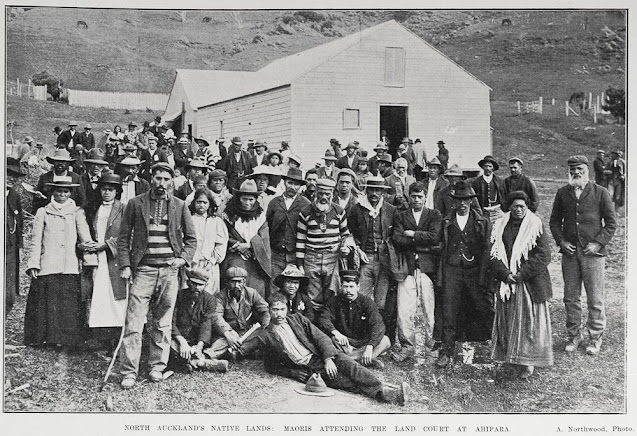Māori Land Court Minute Books - Part 1
 |
| Image: North Auckland's Native Lands: Maoris attending the Land Court at Ahipara (1904) Sir George Grey Special Collections, Auckland Libraries, AWNS-19041027-11-1 |
The Māori Land Court minute books are a very important resource for whakapapa research. They are also valuable for local history, early Māori history, and Waitangi Tribunal research.
"Whakapapa literally means the ‘laying down of generations’ layer upon layer. Whakapapa is about people, it is a link to tūpuna, to heritage, to identity. For Māori it is a taonga, and for many it is also tapu. Traditionally whakapapa was handed down orally to a member of the whānau deemed appropriate to look after the whānau whakapapa." (Paewai, 2015, p2).
The Native Land Court (renamed Māori Land Court in 1947) was established in 1865 with the purpose of translating customary Māori land ownership into legal land titles recognisable under English Law.
Traditional Māori land rights involved communal ownership of land. The hapū (sub tribe) or iwi (tribe) had to prove their traditional rights to land on the basis of occupation, conquest, or ancestry. The gifting of land was also taken into account. Occupation was symbolized by the term "ahi kaa" meaning "to keep the home fires burning". This meant that the hapū had to establish their genealogical connections as well as their physical and emotional ties to a piece of land… When an owner of Māori land dies it is necessary for the person or persons succeeding to that land, to prove their entitlement or right of succession. To do this they must present their whakapapa to the Māori Land Court. (Paewai, 2015, p6).
The Māori Land Court is still in operation, and is organised by seven districts: Taitokerau, Waikato-Maniapoto, Tairāwhiti, Waiariki, Aotea, Tākitimu, and Waipounamu. View maps and details of district offices. Current ownership of Māori land can be searched through Māori Land Online.
As Māori were brought before the court to determine native land entitlements and ownerships, the oral traditions of Māori citing their relationship to the land and the ancestors of it were recorded in the historical minute books. These recitals provide a profound insight into the heritage of the land and the people referred to. (Clement, 2012)
 |
| Image: Page from Kaipara Minute Books (Taitokerau Court) Volume 2 3 Sept 1866 - 9 March 1871. |
The original minute books are held by the Māori Land Court. Photocopied or microfilmed versions are held elsewhere, including some large public and tertiary libraries and branch National Archives offices.
In recognition of their value as a unique archival resource and taonga Māori, in 2012 the minute books were listed in UNESCO’s New Zealand Memory of the World documentary heritage register.
It should be noted that there are four types of minute books:
- District minute books
- Judges / Commissioners minute books
- Appellate minute books (appeals were held by a special Native Appellate Court from 1894 onwards)
- Papatipu / Papatupu minute books – these are held in district offices only. District offices also hold additional records (block order files, application files, correspondence files, whakapapa files and nominal indexes for owners of land)
- Auckland Central Research Centre - all districts on microfilm, hard copies of the following minute books: Northern, Auckland, Hauraki, Ōrākei, Kaipara, Mahurangi, Taitokerau, Waikato
- South Auckland Research Centre - all districts on microfilm
- West Auckland Research Centre - all districts on microfilm, all districts in hard copy
- North Auckland Research Centre - hard copies of the following minute books: Auckland, Kaipara, Mahurangi and Ōrākei
 |
| Image; A sitting of the Native Land Court at Temuka, Canterbury’ (1926) Sir George Grey Special Collections, Auckland Libraries, AWNS-19260916-49-4. |
It is important to acknowledge that the processes around applying for Native Land Court title were complex and problematic, and some of the content in the minute books is controversial and subject to dispute. The rush from the Crown to individualise title resulted in errors, and representations were sometimes received from those without a genuine mandate. See the Te Ara entry Te ture - Maori and legislation and the Auckland University Library's About the minute books and index section for further information.
Part 2 of this post covers searching the Māori Land Court minute books.
References
Clement, Christine (2012). ‘Discovering Māori links. Inside History, Jan/Feb, p42-44.
Paewai, Raewyn (2015) ‘Whakapapa for Beginners’. [Handout produced for Auckland Libraries’ workshops and customer use.]
Author: Rachel, Reference Librarian - Heritage
With assistance kindly provided by:
Robert Eruera, Senior Librarian Pou Ārahi Taonga
Raewyn Paewai, Senior Librarian Māori Research
Linda Hogan, Librarian – Research
I would also like to acknowledge the talk on this subject given by Margaret Ngaropo, former Pou Kohinga Matua
Comments
Post a Comment
Kia ora! Please leave your comment below.